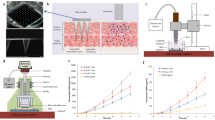Abstract
Purpose. Application of low-frequency ultrasound has been shown to increase skin permeability, thereby facilitating delivery of macromolecules (low-frequency sonophoresis). In this study, we seek to determine the dependence of transport pathways during low-frequency sonophoresis on ultrasound parameters.
Methods. Pig skin is exposed to low-frequency ultrasound over a range of frequencies to achieve different skin resistivities. The porous pathway model is used to study the dependence of average pore size, porosity, and tortuosity on ultrasound parameters. Imaging experiments are also carried out to visualize the transport pathways created by ultrasound.
Results. The data show that the average pore size, determined from the porous pathway model, does not depend on application frequency. Both in the presence and absence of ultrasound the average pore size determined from mannitol delivery is the same (28 ± 12 Å). With the application of ultrasound the skin porosity could be increased by up to 1700-fold. The effect of ultrasound on skin is heterogeneous thereby creating localized transport pathways (LTP). The porosity of these transport pathways is of the same order of magnitude as that of the dermis.
Conclusions. With this study it is shown that low-frequency ultrasound increases skin permeability by increasing skin porosity rather than by increasing the size of the pores that are responsible for permeant delivery.
Similar content being viewed by others
REFERENCES
G. A. Simon and H. I. Maibach. The pig as an experimental animal model of percutaneous permeation in man: qualitative and quantitative observations-an overview. Skin Pharmacol. Appl. Skin Physiol. 13:229–234 (2000).
P. M. Elias. Epidermal lipids, barrier function, and desquamation. J. Invest. Dermatol. 80:44–49 (1983).
T. M. Suhonen, J. A. Bouwstra, and A. Urtti. Chemical enhancement of percutaneous absorption in relation to stratum corneum structural alteration. J. Control. Release 59:149–161 (1999).
B. Forslind, S. Engstrom, J. Engblom, and L. Norlen. A novel approach to the understanding of human barrier function. J. Dermatol. Sci. 14:115–125 (1997).
K. A. Walters and J. Hadgraft. Pharmaceutical Skin Penetration Enhancement, Marcel Dekker, New York, 1993.
R. B. Walker and E. W. Smith. The role of percutaneous penetration enhancers. Adv. Drug Deliv. Rev. 18:295–301 (1996).
Y. N. Kalia and R. H. Guy. Interaction between penetration enhancers and iontophoresis: Effect on human skin impedance in vivo. J. Control. Release 44:33–42 (1997).
M. R. Prausnitz, V. Bose, R. Langer, and J. C. Weaver. Electroporation of mammalian skin: A mechanism to enhance transdermal drug delivery. Proc. Natl. Acad. Sci. USA 90:10504–10508 (1993).
D. Levy, J. Kost, Y. Meshulam, and R. Langer. Effect of ultrasound on transdermal drug delivery to rats and guinea pigs. J. Clin. Invest. 83:2974–2978 (1989).
S. Mitragotri, D. Blankschtein, and R. Langer. Transdermal drug delivery using low frequency sonophoresis. Pharm. Res. 13:411–420 (1996).
S. Mitragotri, D. Blankschtein, and R. Langer. Ultrasoundmediated transdermal protein delivery. Science 269:850–853 (1995).
W. Gaertner. Frequency dependence of acoustic cavitation. J. Acoust. Soc. Am. 26:977–980 (1954).
A. Tezel, A. Sens, J. Tuchscherer, and S. Mitragotri. Frequency dependence of sonophoresis. Pharm. Res. 18:1694–1700 (2001).
H. Tang, S. Mitragotri, D. Blankschtein, and R. Langer. Theoretical description of transdermal transport of hydrophilic permeants: Application to low-frequency sonophoresis. J. Pharm. Sci. 90:545–568 (2001).
S. K. Li, A. H. Ghanem, K. D. Peck, and W. I. Higuchi. Pore induction in human epidermal membrane during low to moderate voltage iontophoresis: A study using AC iontophoresis. J. Pharm. Sci. 88:419–427 (1999).
M. Sznitowska, S. Janicki, and A. C. Williams. Intracellular or intercellular localization of the polar pathway of penetration across stratum corneum. J. Pharm. Sci. 87:1109–1114 (1998).
G. Cevec and H. Richardsen. Lipid vesicles and membrane fusion. Adv. Drug Deliv. Rev. 38:207–232 (1999).
W. M. Deen. Hindered transport of large molecules in liquidfilled pores. AIChE. 33:1409–1424 (1987).
S. Mitragotri, D. Ray, J. Farrell, H. Tang, B. Yu, J. Kost, D. Blankschtein, and R. Langer. Synergistic effect of Low-Frequency Ultrasound and Sodium Lauryl Sulfate on Transdermal Transport. J. Pharm. Sci. 89:892–900 (2000).
A. Tezel, A. Sens, J. Tuchscherer, and S. Mitragotri. Synergistic effect of low frequency ultrasound and surfactants on skin permeability. J. Pharm. Sci. 91:91–100 (2002).
Author information
Authors and Affiliations
Corresponding author
Rights and permissions
About this article
Cite this article
Tezel, A., Sens, A. & Mitragotri, S. A Theoretical Analysis of Low-Frequency Sonophoresis: Dependence of Transdermal Transport Pathways on Frequency and Energy Density. Pharm Res 19, 1841–1846 (2002). https://doi.org/10.1023/A:1021493424737
Issue Date:
DOI: https://doi.org/10.1023/A:1021493424737



